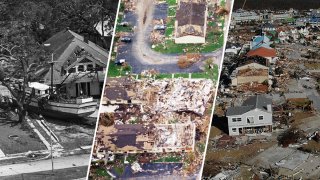
The most punishing of hurricanes bring deaths and catastrophic destruction, lifting roofs off homes, toppling trees, snapping power lines and causing billions in damage.
Category 5 storms are the most dangerous, defined by sustained winds of 157 miles an hour or more. According to the Saffir-Simpson Hurricane Wind Scale, they leave a high percentage of framed homes destroyed, residential areas isolated by fallen trees and power poles and power outages that last for weeks at least. Most of the areas that are hit are uninhabitable for weeks or months.
The wind scale does not take into account storm surges, flooding or tornadoes, all of which also can be deadly.
Get top local stories in DFW delivered to you every morning. Sign up for NBC DFW's News Headlines newsletter.
Before Hurricane Ian, which made landfall as a 150-mph Category 4 system, four Category 5 hurricanes have made landfall in the United States since the early 1900s. Here they are:
Hurricane Michael, 2018
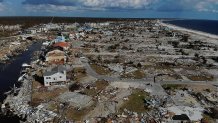
Hurricane Michael made landfall in the Florida Panhandle, causing 16 direct deaths and 43 indirect deaths.
U.S. & World
With top wind speeds of 162 miles per hour and maximum sustained winds of 161 miles per hour, it caused damage from wind and storm surges, especially from Panama City Beach to Mexico Beach to Cape San Blas.
Hurricane Michael left $25 billion in damage, destroying 3,374 homes.
The storm remained at hurricane strength into southwest Georgia.
Hurricane Andrew, 1992
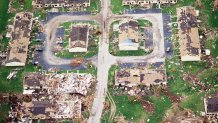
Hurricane Andrew struck in the early morning hours of Aug. 24, 1992, hitting with devastating force in southern Florida. The storm had a top wind speed of 174 miles per hour. It killed 15 people directly and another 28 indirectly, according to the National Weather Service. All but three of the deaths were in what was then called Dade County, now Miami-Dade County.
The storm caused about $26 billion damage, a record until Hurricane Katrina 13 years later. Most of the damage occurred in the southern part of Dade County. Some 49,000 homes were destroyed and another 108,000 were damaged. The hardest hit community was Homestead, where more than 99% of mobile homes or 1,167 out of 1,176 were demolished.
Hurricane Camille, 1969
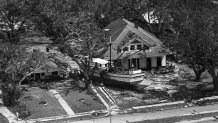
Hurricane Camille struck along the Mississippi Gulf Coast near Waveland late on Aug. 17, 1969.
According to the National Weather Service, Camille ranks as the second most intense hurricane to strike the continental United States in terms of atmospheric pressure and wind speed. It was weaker than the 1935 Labor Day Hurricane and slightly stronger than Hurricane Andrew and Hurricane Michael.
The hurricane destroyed all of the wind-recording instruments in the area, according to the National Weather Service, so the actual maximum sustained winds are not known. Peak winds were about 175 miles per hour, according to later analysis of data.
It caused about $11.3 billion in damage, in adjusted costs. The value is based on the 2022 Consumer Price Index adjusted cost.
Labor Day Hurricane, 1935
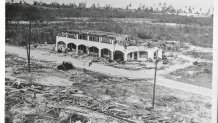
The Labor Day hurricane hit the Florida Keys on Sept. 2, 1935, causing at least 485 deaths.
It crossed the Florida Keys between Key West and Miami, Florida, with maximum sustained winds of about 185 miles an hour.
Those included about 260 World War I veterans who were working on the Overseas Highway in a federal relief project. They were from the Bonus Army, soldiers who camped out at the steps of the U.S. Capitol in the early 1930s to demand compensation promised by the federal government, according to the Library of Congress. They were dispersed by U.S. Army troops under the command of General Douglas MacArthur in 1932.
A rescue train failed to reach them and Ernest Hemingway wrote an essay, "Who Murdered the Vets?" that was published days after the hurricane.
It likely caused more than $6 million in property loss in Florida as it cut a path of destruction 40 miles wide across the Keys. Most manmade structures were demolished.
After the storm, additional monitoring stations were set up in southern Florida and disaster preparedness was improved along the coast.
Hurricane Sandy, 2012
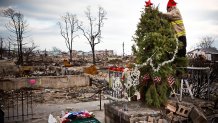
Hurricane Sandy struck near Atlantic City, N.J. on Oct. 29, 2012. In New York City, it left 44 people dead and destroyed about 300 homes. In the end, it did about $81.9 billion in damage in adjusted dollars. Despite the destruction it caused, it made U.S. landfall as a Category 3 storm.
Hurricane Katrina, 2005
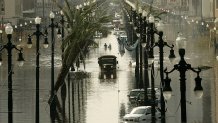
Hurricane Katrina, which hit Louisiana and Mississippi, was one of the deadliest hurricanes to strike the United States.
It was responsible for 1,833 deaths and about $108 billion in damage. New Orleans was especially hard hit when levees separating New Orleans from Lake Pontchartrain broke. At one point, 80% of New Orleans was underwater.
But although deadly and destructive, it was a Category 3 hurricane when it made U.S. landfall.



